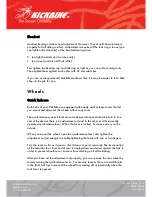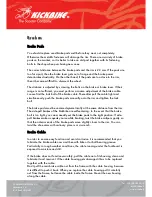
13
13
KICKBIKE WORLDWIDE OY
Mikkolantie 1 A
FI – 00640 HELSINKI
Tel. +358 (0)9 388 3013
info@kickbike.fi
www.kickbike.fi
Uphill
In spite of some false preconceptions, you can ride your Kickbike nicely also uphill.
You need to master the technique, though, in order to take advantage of the light
9 kg weight compared to an ordinary bike.
When the road starts to ascend, the Kickbike tends to slow down noticeably
between the kicks. However, don't slow down consciously. Instead, alter your
technique.
Increase frequency. Take shorter kicks. Change your pendulum-like kick to a
rotating one. When you keep your kicking knee slightly bent you can bring the leg
quickly back to the front for a new kick. In the kicking phase, however, try keep
your legs straight avoiding excess vertical movement.
If you wish to increase your frequency further, you need to learn the jump-change
of the leg. Jump immediately after you have kicked and are bringing your kicking
foot to the front. A low, almost inconspicuous jump does not waste too much
energy.
If the hill is too steep for your fitness or skill, don't be discouraged. It is extremely
easy to move into running or walking. For a beginner this is often the most
convenient alternative.
Downhill
When the velocity downhill increases enough, you will soon notice that it's better to
stop kicking. It is easiest to stand on the footboard with both feet pointing slightly
aside to the same direction.
At the end of the descent let your Kickbike roll while the velocity decreases to your
normal kicking speed. A beginner often starts kicking while the speed is still too
high and touching the ground only slows the journey.
Always reserve enough room for braking by adjusting your velocity according to
visibility. It takes more time to stop in downhill than on flat land.































